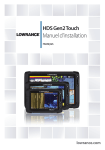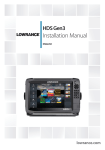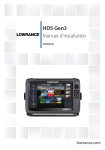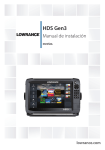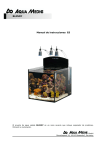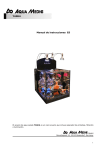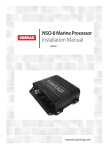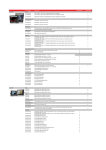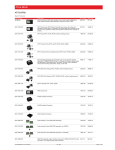Download Real Cable HDS-12 Installation manual
Transcript
HDS Gen2 Touch Installation Manual ENGLISH lowrance.com Preface As Navico is continuously improving this product, we retain the right to make changes to the product at any time which may not be reflected in this version of the manual. Please contact your nearest distributor if you require any further assistance. It is the owner’s sole responsibility to install and use the instrument and transducers in a manner that will not cause accidents, personal injury or property damage. The user of this product is solely responsible for observing safe boating practices. NAVICO HOLDING AS AND ITS SUBSIDIARIES, BRANCHES AND AFFILIATES DISCLAIM ALL LIABILITY FOR ANY USE OF THIS PRODUCT IN A WAY THAT MAY CAUSE ACCIDENTS, DAMAGE OR THAT MAY VIOLATE THE LAW. Governing Language: This statement, any instruction manuals, user guides and other information relating to the product (Documentation) may be translated to, or has been translated from, another language (Translation). In the event of any conflict between any Translation of the Documentation, the English language version of the Documentation will be the official version of the Documentation. This manual represents the product as at the time of printing. Navico Holding AS and its subsidiaries, branches and affiliates reserve the right to make changes to specifications without notice. Copyright Copyright © 2012 Navico Holding AS. Warranty The warranty card is supplied as a separate document. In case of any queries, refer to the brand web site of your display or system: www.lowrance.com Declarations and conformance This equipment is intended for use in international waters as well as inland waters and coastal sea areas administered by countries of the USA, E.U. and E.E.A. |1 Compliance Statements Lowrance HDS-7, HDS-9, and HDS-12 Gen2 Touch: • meet the technical standards in accordance with Part 15.103 of the FCC rules • comply with CE under RTTE directive 1999/5/EC • comply with the requirements of level 2 devices of the Radiocommunications (Electromagnetic Compatibility) standard 2008 For more information please refer to our website: www.lowrance.com Warning The user is cautioned that any changes or modifications not expressly approved by the party responsible for compliance could void the user’s authority to operate the equipment. This equipment has been tested and found to comply with the limits for a Class B digital device, pursuant to Part 15 of the FCC rules. These limits are designed to provide reasonable protection against harmful interference in a residential installation. This equipment generates, uses and can radiate radio frequency energy and, if not installed and used in accordance with the instructions, may cause harmful interference to radio communications. However, there is no guarantee that the interference will not occur in a particular installation. If this equipment does cause harmful interference to radio or television reception, which can be determined by turning the equipment off and on, the user is encouraged to try to correct the interference by one or more of the following measures: • Reorient or relocate the receiving antenna • Increase the separation between the equipment and receiver • Connect the equipment into an outlet on a circuit different from that of the receiver • Consult the dealer or an experienced technician for help 2| About this manual This manual is a reference guide for installing the Lowrance HDS-7, HDS-9, and HDS-12 Gen2 Touch system. The manual does not cover basic background information about how equipment such as radars, echo sounders and AIS work. Such information is available from our web site: http://www.lowrance.com/Support/Library/ Important text that requires special attention from the reader is emphasized as follows: ¼¼ Note: Used to draw the reader’s attention to a comment or some important information. ! Warning: Used when it is necessary to warn personnel that they should proceed carefully to prevent risk of injury and/or damage to equipment/personnel. Trademarks • ‘NMEA 2000’ is a registered trademark of the National Marine Electronics Association • ‘Navionics’ is a registered trademark of Navionics SpA • ‘Simrad’ is a trademark of Kongsberg Maritime AS Company registered in the US and other countries and is being used under license. • ‘HDS’, ‘StructureScan’, ‘Navico’, ‘Lowrance’, ‘SonicHub’, ‘SimNet’ and ‘Skimmer’ are trademarks of Navico, registered in the US and other countries. ‘InsightHD’, ‘Broadband Radar’ and ‘Broadband Sonar’ are trademarks of Navico. |3 Contents 6 HDS Gen2 Touch overview 7 8 9 Front - controls Rear - connectors SD card slot 10 Check the contents 11 Display Installation 11 Mounting location 12 Bracket mounting 13 Flush mounting 14Research 14 Select a transducer location 15 Attaching the transducer 16 Adjusting the transducer 17Wiring 17Guidelines 18 Power connection 20 Transducer connection 21 Ethernet device connection 22 NMEA 2000 device connection 24 NMEA 0183 device connection 25 Video In 25 Connecting video sources 4| 26 Software setup 26 28 28 Sonar installation settings Touch Screen Calibration Software upgrades 29 Dimensional drawings 29 29 29 HDS 7 Gen2 Touch HDS 9 Gen2 Touch HDS 12 Gen2 Touch 30Accessories 30 NMEA 2000 30Transducers 31 Ethernet cables 31 Display parts 33 Supported data 33 34 NMEA 2000 NMEA 0183 35Specifications |5 1 6| HDS Gen2 Touch overview The HDS-7, HDS-9, and HDS-12 Gen2 Touch multifunction displays are available with or without inbuilt sonar and structure scan. The ability to network over NMEA 2000 and ethernet allows access to data as well as control of numerous optional devices that can provide sonar, radar, audio entertainment, weather and even digital switching. All displays are charting ready, with built-in GPS receiver and Insight cartography (region dependent) and with optional Navionics support via an SD card slot. The displays may be mounted on to the vessel with the supplied surface mount bracket, or flush mounted in to the dash. Power should be supplied at around 12V, but due to the variable nature of boat power systems, the displays are designed to operate on 10.8 V - 17 V. HDS Gen2 Touch overview | HDS Gen2 Touch Installation Manual Front - controls 1 3 4 2 5 6 1 Touchscreen 2 Card reader door 3 Pages key 4 Zoom in / Zoom out key 5 Mark / Waypoint key 6 Power key HDS Gen2 Touch overview | HDS Gen2 Touch Installation Manual |7 Rear - connectors B A 1 2 3 4 4 5 4 5 1 2 A HDS-9 & 12 connector arrangement B HDS-7 connector arrangement 1 Sonar 2 StructureScan - connects to LSS-2 HD Transducer 3 Power - also video for HDS-9 & 12, with optional adaptor 4 Ethernet - two ports on HDS-9 & 12, one on 7 5 NMEA 2000 8| HDS Gen2 Touch overview | HDS Gen2 Touch Installation Manual 3 SD card slot Used for optional Navionics or InsightHD chart data, software updates, transfer of user data and system backup. The card reader door is opened by lightly pressing and sliding the door to the left, then pulling forward from the left side. The card reader door should always be shut immediately after inserting or removing a card, in order to prevent possible water ingress. ¼¼ Note: The HDS-9 and 12 Displays have two card readers, the HDS-7 has one. HDS Gen2 Touch overview | HDS Gen2 Touch Installation Manual |9 2 Check the contents Display Bracket knobs (x2) Front Bezel (attached to unit) Power cable Sun cover Fasteners - #6 x 1.5” (4x) Mounting bracket Parts Included, dependent on model 10 | 83/200 KHz transducer LSS-2 HD transducer 50/200 KHz transducer DVD - manuals Check the contents | HDS Gen2 Touch Installation Manual 3 Display Installation Mounting location Choose the mounting locations carefully before you drill or cut. The display should be mounted so that the operator can easily use the controls and clearly see the display screen. Be sure to leave a direct path for all of the cables. Lowrance displays are high-contrast and anti-reflective, and are viewable in direct sunlight, but for best results install the display out of direct sunlight. The chosen location should have minimal glare from windows or bright objects. Ensure that any holes cut are in a safe position and will not weaken the boat’s structure. If in doubt, consult a qualified boat builder. Before cutting a hole in a panel, make sure that there are no hidden electrical wires or other parts behind the panel. Do not mount any part where it can be used as a hand hold, where it might be submerged, or where it will interfere with the operation, launching or retrieving of the boat. If bracket mounting the display, choose an area where the display will not be subjected to excessive vibration. The mounting location will affect the internal GPS receiver. Test the unit in it’s intended location to ensure satisfactory reception. An external GPS source may be added to overcome poor reception areas. Leave sufficient clearance to connect all relevant cables. Good ventilation is required. Inadequate ventilation may cause the display to overheat. Lowrance displays are designed to operate in temperatures from -15° C to +55° C (+5° F to +131° F). For overall width and height requirements, please see the dimensions section on page 29. ! Warning: When installing the displays, ensure appropriate safety equipment is used, eg. ear muffs, protective glasses, gloves and a dust mask. Power tools may exceed safe noise levels, and can cast off dangerous protectiles. The dust from many materials commonly used in boat construction may cause irritation or damage to eyes, skin, and lungs. Display Installation | HDS Gen2 Touch Installation Manual | 11 Bracket mounting Place the bracket in the desired mounting location, and use a pencil or permanent marker to mark drilling locations. ¼¼ Note: ensure that the chosen location has enough height to accomodate the display fitted in the bracket, and allows tilting of the display. Also adequate space is required on both sides to allow tightening and loosening of the knobs. Use fasteners suited to the mounting surface material. If the material is too thin for self tappers, reinforce it, or mount bracket with machine screws and large washers. Use only 304 or 316 stainless steel fasteners. Mark the screw locations using bracket as template, and drill pilot holes. Screw down the bracket. 12 | Mount the display to the bracket using the knobs. Hand tighten only. The ratchet teeth in the bracket and display case ensure a positive grip and prevent the unit changing from the desired angle. Display Installation | HDS Gen2 Touch Installation Manual Flush mounting Check the template for scaling accuracy, using a tape measure or ruler against the ruler printed on the template. 95. 3 mm (7. 50" ) MO UNT ING SCR EW SIZ E IS 110.2 mm (3.75") #6 99.5 mm (3.92") TAP 95. PIN G 3 C L SCR EW mm (7. 50" ) SU PR N OD UC T CO VER OU TLI C L NE 190 .5 mm (7. 50" ) 199.0 mm (7.83") 220.4 mm (8.68") Check dimensions before cutting 12" Cut away excess paper, and tape down the template. Check it is correctly aligned to a vertical or horizontal reference. Do not use a bubble level as vessel may be listing! Adjust where required. Drill all marked pilot holes, then using an appropriate saw, cut through the template and mounting surface, along the dotted line bordering the shaded center of the template. Remove the bezel from the display, using a fingernail or small flat screwdriver, starting at the edges that are closest to the card reader door. Check the fit of the display, and use a file to remove any remaining obstructions. If water-tightness is required, apply a thin, continuous bead of sealant to the back of the display prior to final installation. Sealant should be of a ‘neutral cure’ type to prevent damage to the plastics. Secure the display with the supplied screws. Once screws are fully tightened, ensure there is complete contact with the mounting surface. Lastly, fit the bezel with the card reader door open; insert the outermost tabs on the bezel in to the slots on the display, then gently press down the bezel above and below the card reader door till it clicks in to place. Display Installation | HDS Gen2 Touch Installation Manual | 13 4 Mounting the transducer Transducer location selection and installation are two of the most critical steps in sonar installation. To function properly the transducer must be in the water at all times, and in a location that has a smooth flow of water when the boat is moving. Research Before starting the installation of the transducer, it’s advised to check the following; • Find out if the boat builder has a recommended installation location • Establish direction of rotation of the propeller(s) • Watch actual water flow when boat is travelling at cruising speed to determine the area of transom with cleanest flow (least bubbles) Select a transducer location The primary aim is to stay clear of propeller and hull generated turbulence, while mounting the transducer as close to the center of the vessel as possible. 1 2 3 4 5 1 Avoid mounting within 1m (3.3’) to port of propeller 2 Conventional clockwise propeller rotation 3 Avoid mounting within 7.5cm (3“) to starboard of propeller 4 Best mounting location - undisturbed water flow 5 Planing strake - avoid mounting behind here ¼¼ Note: Reverse the distance guides (1 & 3) from propeller where engine is of counterclockwise configuration. 14 | Display Installation | HDS Gen2 Touch Installation Manual ¼¼ Note: Boats with strakes or ribs on the hull can create large amounts of turbulence at higher speeds. A good transducer location on these types of boats is between the ribs closest to the engine. ¼¼ Note: If the transducer is not placed in a smooth flow of water, interference caused by bubbles and turbulence may show onscreen in the form of random lines or dots. The unit could also lose bottom signal when the boat is on plane. ¼¼ Note: Trim tabs will vary in the amount of turbulence they create as they are adjusted, stay clear of these. Attaching the transducer The transducer should be installed parallel with the transom’s waterline, not the bottom of the boat (deadrise). ¼¼ Note: Ensure the entire bottom surface of the transducer hangs at least couple of millimetres (1/16ths of an inch) lower than the bottom of the hull. Hold the transducer with bracket up to the transom of the boat and trace the slotted screw hole locations (two on the 83/200 KHz transducer, and four on the 50/200 KHz transducer). Mark drilling points in the middle of each outline, to allow for transducer height adjustment. Drill pilot holes to suit fasteners. ¼¼ Note: Check that there is nothing on the other side of the mounting surface that may be damaged by drilling. Attach transducer to transom, using supplied stainless steel fasteners. Drill a 25mm (1”) hole above the waterline, large enough to pass the plug through. Display Installation | HDS Gen2 Touch Installation Manual | 15 Secure the cable to the hull at regular intervals using cable P clips or saddles and ensure that moving parts such as an outboard motor or boarding ladder can’t snag the cable. Adjusting the transducer If the sounder image shows interference lines on the screen when moving, which worsen with speed, it may be possible to eliminate these by adjusting the transducer’s angle. ¼¼ Note: A transducer that is tilted too far in either direction will not perform well, missing targets, and/or losing the bottom at speed. If performance does not improve with tilting, try adjusting the height of the transducer relative to the transom of the boat. If the transducer is too high it may be seeing cavitation caused by the trailing edge of the transom. 16 | Display Installation | HDS Gen2 Touch Installation Manual 5 Wiring Guidelines Don’t do this Do this Don’t make sharp bends in the cables Don’t run cables in a way that allows water to flow down into the connectors Don’t route the data cables in areas adjacent to radar, transmitter, or large current carrying cables Do make drip and service loops Do cable tie all cables to keep them secure Do solder/crimp and insulate all wiring connections, if extending or shortening power or NMEA 0183 cables Do leave room at the back to install and remove cables ! Warning: Before starting the installation, be sure to turn electrical power off. If power is left on or turned on during the installation, fire, electrical shock, or other serious injury may occur. Be sure that the voltage of the power supply is compatible with the HDS Gen2 Touch display ! Warning: The HDS Gen2 Touch has a voltage rating of 12 V DC, it is not suited for use with 24V DC systems. ! Warning: The positive supply wire (red) should always be connected to (+) DC with the supplied fuse or a circuit breaker (closest available to fuse rating). Wiring | HDS Gen2 Touch Installation Manual | 17 Power connection HDS Gen2 Touch displays are designed to be powered by a 12 V DC system. They are protected against reverse polarity, under voltage and over voltage. The plug of the supplied power cable has two discrete cables exiting from it. The thickest cable provides the following: • power into the system (Red and Black wires) • remote turn-on for certain Navico expansion modules (Yellow wire) 4 1 2 3 6 5 _ + 1 HDS display rear (9 & 12 connector arrangement shown) 2 Power cable 3 12 V negative wire (black) 4 12 V positive wire (red) shown with fuse holder fitted 5 Accessory Wake Up wire (yellow) 6 Vessel’s 12 V DC supply Connect red to (+) DC using a 5 A fuse. Connect Black to (-) DC. Accessory wake up The yellow colored accessory wake up line may be used to control the power state of Navico modules such as SonicHub, StructureScan, and Broadband radar. This means that the modules are turned on the moment the display is powered up. ¼¼ Note: Broadband radar will be put in standby, when triggered by the accessory wake up line. For connection, simply combine all yellow wires on a common bus or to a single termination point. 18 | Wiring | HDS Gen2 Touch Installation Manual The following demonstrates the power connections for a small system. 1 2 3 4 5 6 7 + _ 8 1 HDS Displays 2 HDS power cable 3 Broadband radar interface 4 SonicHub 5 12 V DC negative (-) 6 12 V DC postive (+) 7 Accessory wake up line 8 Vessel’s 12 V DC supply Wiring | HDS Gen2 Touch Installation Manual | 19 Transducer connection All Combo HDS Gen2 Touch displays have internal Broadband and StructureScan sonar (chart only units require an external module for sonar). Navico transducers fitted with the 7 pin blue connector can be plugged directly into the corresponding blue socket labeled ‘Sonar’. The 9 pin black structure scan connector can be plugged in to the socket labelled ‘Structure’ . Refer to the Overview section of this manual, or embossed labeling on the unit for connector location. Connector attached to cable is keyed and can only be inserted in one orientation. Once inserted, turn locking collar to secure. ¼¼ Note: Connectors are not in same location on the HDS-7 display as they are on the HDS-9 and 12 displays (shown above). The ‘Structure’ connector is located to the right of the ‘Sonar’ connector on all units. ¼¼ Note: Sonar data can also be supplied by an external sonar source such as the BSM-2 or another sonar capable Navico display connected via ethernet. ¼¼ Note: While made for LSS-2 HD transducer, the displays are also compatible with earlier LSS-1 transducers through use of an adaptor cable - see page 30. 20 | Wiring | HDS Gen2 Touch Installation Manual Ethernet device connection Ethernet is used to interconnect high bandwidth devices such as radar, sonar, and other displays. The HDS-7 display has one ethernet port, whereas the HDS-9 and 12 displays have two. Navico ethernet cables have a locking collar, for maintaining a reliable, waterproof connection. Connecting directly to a single device The ethernet port is auto sensing, meaning that the unit can connect to one network device directly, without the use of a crossover cable or switch. Connecting to multiple devices If connecting more than one ethernet device to a HDS-7 display, or two devices to a HDS-9 or HDS-12 display, use the optional network expansion Port (NEP-2). If the number of ethernet devices exceeds the number of available ports on the NEP-2, it is possible to link two or more NEP-2 modules together to provide the required ports. The NEP-2 modules are fitted with 5 ethernet ports. See page 31 for cable options. ¼¼ Note: When designing a system, take in to account the ports ‘lost’ when used for linking multiple NEP-2 modules together. Wiring | HDS Gen2 Touch Installation Manual | 21 NMEA 2000 device connection All HDS Gen2 Touch models are equiped with a NMEA 2000 port, which allows the receiving and sharing of a multitude of data from various sources. Essential network information • A NMEA 2000 network consists of a linear “backbone” from which “drop cables” connect to NMEA 2000 devices • NMEA 2000 is a powered network. • NMEA 2000 cables used for Lowrance products are of the ‘micro-c’ style, which is a cable/connector specification approved for use in NMEA 2000 certified networks. • A single drop cable has a maximum length of 6 m (20 ft). The total length of all drop cables combined should not exceed 78m (256 ft) • The backbone has a maximum cable length of 100m (328ft). The maximum cable length between any two devices on the network is also 100 m (328 ft) - this is taking in to account device drop cable length. • A NMEA 2000 network needs to have a terminator at each end of the backbone. Planning and installing a network backbone The NMEA 2000 backbone needs to run between the locations of all products you want to install, typically in a bow to stern layout. Route the backbone so that drop cables to devices do not exceed 6m length. Choose from the following components to make up your NMEA 2000 backbone: • Micro-C cables: 2’ (0.61m), 6’ (1.82m), 15’ (4.55m), 25’ (7.58m) • T-connector. Use at locations where you want to connect a device by drop cable • Micro-C male and Micro-C female to SimNet adaptor cables for connecting to SimNet bus, or adding devices fitted with a SimNet connector to a Micro-C network. ¼¼ Note: If using a wind sensor, plan to connect this to one end of the backbone with the termination resistor at the mast head. Power the network A NMEA 2000 network requires its own 12 V DC power supply. The Lowrance NMEA 2000 power cable is pre fitted with an inline fuse holder and 3 amp fuse. 22 | Wiring | HDS Gen2 Touch Installation Manual In smaller NMEA 2000 systems, the power connection may be made anywhere in the system, For larger systems introduce power at a central point in the backbone to ‘balance’ the voltage drop of the network. Use a power cable without termination. ¼¼ Note: When joining a NMEA 2000 network with a Simrad SimNet network, it is important that you do not introduce power to both. ¼¼ Note: Do not connect the power cable to the same terminals as the autopilot computer, pulse radar, bow thruster or other high current devices - the network may be affected by voltage drop when these devices are operated. Avoid connection to the engine starting batteries where possible. The following diagram demonstrates a typical small NMEA 2000 network: 1 3 2 4 5 _ + 12 V DC T 6 9 T 7 8 9 1 GPS antenna 2 HDS Display 3 Broadband radar interface 4 SonicHub 5 ‘Drop’ cables (should not exceed 6m (20’) each) 6 Power cable 7 Micro-C T junctions 8 Backbone 9 Micro-C terminator (one male, one female) Wiring | HDS Gen2 Touch Installation Manual | 23 NMEA 0183 device connection The HDS has a NMEA 0183 serial port, providing both an input and output for NMEA 0183 data. The port can be set to different baud rates, up to 115,200 baud. The NMEA0183 sentences output can be individually turned on or off. Refer to the section Supported Data / NMEA 0183 for a complete list of sentences. 1 2 3 4 1 Data cable (combined in same plug as power cable) 2 Transmit: A (yellow), B (blue) 3 Receive: A (orange), B (green) 4 ground (shield) ¼¼ Note: The majority of NMEA 0183 devices communicate at 4,800 baud. AIS is a common exception, and normally transmits at 38,400 baud. 24 | Wiring | HDS Gen2 Touch Installation Manual Talkers and Listeners Do not connect multiple devices outputing data (Talkers) on to the input (Rx) of the unit. The RS422 protocol is not intended for this type of connection, and data will be corrupted if more than one device transmits simultaneously. The output however may drive multiple receivers (Listeners). The number of receivers is finite, and depends on the receiving hardware. Typically three devices is possible. Video In On the HDS-9 and HDS-12, a video camera may be added by installing the optional video adaptor cable between the power socket on the unit, and the plug on the power/data cable. ¼¼ Note: The video images will not be shared with another unit via the network. It is only possible to view video on the unit connected to the video source. Connecting video sources 12 V DC 1 2 3 4 1 Video input adaptor cable 2 RCA plug 3 12 V camera (3rd party) 4 HDS power/data cable ¼¼ Note: Only connect NTSC and PAL video sources Wiring | HDS Gen2 Touch Installation Manual | 25 6 Software setup Sonar installation settings Keel offset This is a value that can be entered on the Sonar Installation page to make depth readings relate to any point from the water surface, to the deepest point of the vessel. Below are some typical ways in which the offset is used: A) For Depth below Keel: Set the distance from transducer to the keel. Enter a negative value, e.g. B) For Depth Below Transducer: no offset required. C) For Depth Below Surface (waterline): Set the distance from transducer to the surface: Enter a positive value., e.g. A 26 | B Software setup | HDS Gen2 Touch Installation Manual C Water speed calibration Water speed calibration is used to adjust the speed value from the paddle wheel to match the actual boat speed through the water. Actual speed can be determined from GPS speed over ground (SOG) or by timing the boat over a known distance. Water speed calibration should be performed in calm conditions, with minimal wind and current movement. Water speed averaging Averages water speed by measuring your speed at a selected interval of time. Water speed intervals range from one to thirty seconds, e.g. If you select five seconds, your displayed water speed will be based on averaging over 5 seconds of sampling. Water temperature calibration Temperature calibration is used to adjust the water temperature value from the sonar transducer to match the data from another temperature sensor. It may be required to correct for localized influences to the measured temperature. ¼¼ Note: Water temperature calibration only appears if the transducer is temperature capable. Check transducer type selection if this option should be available. Transducer type Transducer type is used for selecting the transducer model that came with your unit. In some transducers with built-in temperature sensors, the temperature reading may be inaccurate if the wrong transducer is selected from the transducer type menu. Software setup | HDS Gen2 Touch Installation Manual | 27 Touch Screen Calibration In some cases it may be required to re-calibrate the touch screen due to electrical influences on the device from it’s installation environment. The following steps should be completed to apply calibration: 1. Turn the unit off 2. Press and hold the Waypoint key, then turn the unit on 3. Hold the Waypoint key during power on, until the calibration utility screen comes up 4. Touch crosshair shown on screen to perform nine points calibration 5. After successful calibration the unit will return to normal application screen Software upgrades The latest software for this unit will be available for download from the Lowrance web site; www.lowrance.com An SD card and SD reader/writer are required for this. Detailed instructions for how to install the software are provided on the update web page. 28 | Software setup | HDS Gen2 Touch Installation Manual HDS 7 Gen2 Touch 82 mm (3.23") 215 mm (8.48") 7" 166 mm (6.52") 146 mm (5.76") 30 mm (1.18") 240 mm (9.45") 95 mm (3.72") HDS 9 Gen2 Touch 178 mm (7.01") 9" 169 mm (6.65") 30 mm (1.18") 54 mm (2.13") 265 mm (10.43") 287 mm (11.30") 60.5 mm (2.38") HDS 12 Gen2 Touch 30.3 mm (1.19") 328.1 mm (12.92") .1 " 233.6 mm (9.20") 12 60.9 mm (2.4") 224.7 mm (8.85") 7 Dimensional drawings 351.0 mm (13.82") 62 mm (2.44") 82.8 mm (3.26") Dimensional drawings | HDS Gen2 Touch Installation Manual | 29 8 Accessories Refer to website for latest accessories: www.lowrance.com NMEA 2000 Part number 000-0124-69 000-0119-88 000-0127-53 000-0119-86 000-0119-83 000-0120-39 000-0120-41 000-0120-49 000-0120-51 000-0120-53 000-0120-73 000-0120-29 000-0125-28 22090195 Description NMEA 2000 STARTER KIT N2KEXT-2RD 2’ (0.61M) EXTENSION CABLE N2KEXT-6RD 6’ (1.82M) EXTENSION CABLE N2KEXT-15RD 15’ (4.55M) EXTENSION CABLE N2KEXT-25RD 25’ (7.58M) EXTENSION CABLE EP-60R FUEL FLOW SENSOR EP-65R FLUID LEVEL SENSOR EP-70R PADDLE WHEEL SPEED SENSOR EP-80R TEMPERATURE SENSOR EP-80RTH THRU-HULL TEMPERATURE SENSOR EP-85R STORAGE DEVICE EP-90R PRESSURE SENSOR LGC-4000 HIGH SPEED GPS RECEIVER RC42 RATE COMPASS Transducers Part number 000-0106-72 000-0106-74 000-0106-89 000-0106-77 000-0106-94 000-0099-95 000-0099-96 000-0099-97 000-0099-93 000-0099-94 000-10802001 30 | Description HST-WSBL 83/200 TRANSOM SKIMMER WITH TEMP PDT-WBL 83/200 POD WITH TEMP PDRT-WBL 83/200 POD WITH REMOTE TEMP HST-DFSBL 50/200 TRANSOM SKIMMER WITH TEMP PTI-WBL ICE TRANSDUCER TS-1BL EXTERNAL TEMP SENSOR (NON-NMEA 2000) SP-BL TRANSOM SPEED WHEEL (NON-NMEA 2000) ST-TBL TRANSOM SPEED/TEMP (NON-NMEA 2000) XT-12BL 12FT BLUE CONNECTOR TRANSDUCER EXTENSION XT-20BL 20FT BLUE CONNECTOR TRANSDUCER EXTENSION LSS-2 HDS SKIMMER 20 FT STRUCTURESCAN HD SKIMMR XDCR LSS-2 Accessories | HDS Gen2 Touch Installation Manual Part number 000-0136-02 000-0136-03 000-10116-001 000-00021-001 000-0136-05 Description P319 50/200 LOW PROFILE THRU-HULL W/TEMP P79 50/200 IN-HULL TM260 50/200 TRANSOM MOUNT W/TEMP B60 50/200 BRONZE THRU-HULL W/TEMP B744V 50/200 BRONZE THRU-HULL W/TEMP AND SPEED 000-10247-001 000-0136-00 000-0106-82 000-0106-91 22098479 B164 50/200 BRONZE THRU-HULL W/TEMP 1KW B258 50/200 Bronze Thru-Hull w/Temp B260 50/200 Bronze Thru-Hull w/Temp M260 50/200 Tank Mounted In-Hull DST-800 235 NMEA 2000 Smart Sensor w/ Temp and Speed (Digital display only, no sonar image) 000-11040-001 LSS-1 XDCR TO LSS-2 MODULE ADAPTOR Ethernet cables Part Number 000-0127-56 000-0127-51 000-0127-29 000-0127-30 000-0127-37 Description Adapter cable: Ethernet Yellow Male to RJ-45 female 2m (6.5ft) Ethernet cable yellow 5 Pin 2m (6.5ft) Ethernet cable yellow 5 Pin 4.5m (15ft) Ethernet cable yellow 5 Pin 7.7m (25ft) Ethernet cable yellow 5 Pin 15.2m (50ft) Display parts Part Number 000-11010-001 000-11033-001 000-11034-001 000-11035-001 000-11030-001 000-11031-001 000-11032-001 000-11019-001 000-11020-001 000-11021-001 000-11050-001 000-10467-001 Description HDS GEN2 VIDEO ADAPTER CABLE HDS-7 GEN2 TOUCH BEZEL AND CARD DOOR HDS-9 GEN2 TOUCH BEZEL AND CARD DOOR HDS-12 GEN2 TOUCH BEZEL AND CARD DOOR HDS-7 GEN2 TOUCH SUNCOVER HDS-9 GEN2 TOUCH SUNCOVER HDS-12 GEN2 TOUCH SUNCOVER HDS-7 GEN2 TOUCH GIMBAL BRACKET HDS-9 GEN2 TOUCH GIMBAL BRACKET HDS-12 GEN2 TOUCH GIMBAL BRACKET HDS GEN2 TOUCH FLUSH MOUNT KIT BRACKET KNOBS PAIR – NSS/GEN2T Accessories | HDS Gen2 Touch Installation Manual | 31 Part Number 000-0127-49 000-0124-70 000-0127-50 32 | Description HDS Power Cable HDS Connector Caps HDS Fuse & Fuse Holder Accessories | HDS Gen2 Touch Installation Manual 9 Supported data NMEA 2000 PGN 59392 60928 126208 126992 126996 127237 127245 127250 127251 127257 127258 127488 127489 127493 127503 127505 127506 127508 128259 128267 129808 129025 129026 129029 129033 129038 129039 129040 129283 129284 Description ISO Acknowledgement Address Claim NMEA Group Function System Time Product Info Heading/Track Control Rudder Vessel Heading Rate of Turn Attitude Magnetic Variation Engine Parameters Rapid Update Engine Parameters Dynamic Transmission Parameters Dynamic AC Input Status Fluid Level DC Detailed Status Battery Status Speed Water Referenced Water Depth DSC Call Information Position Rapid Update COG & SOG, Rapid Update GNSS Position Data Time and Date AIS Class A Position Report AIS Class B Position Report AIS Class B Extended Position Report Cross Track Error Navigation Data Rx 1 1 1 1 1 1 1 1 1 1 1 1 1 1 1 1 1 1 1 1 1 1 1 1 1 1 1 1 1 1 129285 129539 129540 129794 129801 129802 129808 Route/WP Information GNSS DOPs GNSS Sats In View AIS Class A Static and Voyage Related Data AIS Addressed Safety Related Message AIS Safety Related Broadcast Message DSC Call Information 1 1 1 1 1 1 Supported data | HDS Gen2 Touch Installation Manual Tx 1 1 1 1 1 1 1 1 1 1 1 1 1 1 1 1 1 1 | 33 PGN Description Rx Tx 130074 130306 130310 130311 130312 130313 130314 130576 130577 Waypoint Name and Position Wind Data Environmental Parameters Environmental Parameters Temperature Humidity Actual Pressure Small Craft Status Direction Data 1 1 1 1 1 1 1 1 1 1 1 1 1 1 NMEA 0183 TX / RX Category / Sentence GPS Receive GGA GLL GSA Transmit GGA GLL GSA Navigation Receive RMC Transmit AAM APB BOD Echo Receive DBT DPT MTW Transmit DBT DPT MTW Compass Receive HDG HDT HDM Transmit HDG Wind Receive MWV MWD Transmit MWV AIS / DSC Receive DSC MARPA Transmit TLL DSE GSV VTG GSV VTG ZDA ZDA BWC BWR RMC RMB VLW VHW VLW VHW VDM TTM ¼¼ Note: AIS sentences are not bridged to or from SimNet. 34 | Supported data | HDS Gen2 Touch Installation Manual XTE SD (full size) Specifications | HDS Gen2 Touch Installation Manual 30.5 x 27.9 x 27.9 cm (12" x 11" x 11") 2.54 kg (5.6 lb) Pack dimensions (L x W x H) Pack weight (50/200 or 83/200 kHz) + 455/800 kHz Max power 500W RMS Sonar frequency Sonar output power Echo sounder 1.6 kg (3.5 lb) Weight (display only) Other No Data card slot 1 Port Video input NMEA2000 Ethernet Interface Declaration of conformity Waterproof standard Temperature Housing IPx7 -15° C to + 55° C (+5° F to +131° F) Plastic 15.6 W (1.2 A @ 13 V DC) 12 V DC (10.8 - 17.0 V DC min - max) S-CAP 1400 nits 9 inch WVGA color TFT LCD 800x480 HDS-9 Max power 500W RMS (50/200 or 83/200 kHz) + 455/800 kHz 2.9 kg (6.5 lb) 2 Ports 26 W (2.0 A @ 13 V DC) 12 V DC (10.8 - 17.0 V DC min - max) 1250 nits 12.1 inch WXGA TFT LCD 1280x800 HDS-12 Max power 500W RMS (50/200 or 83/200 kHz) + 455/800 kHz 3.78 kg (8.3 lb) 2x SD (full size) Composite video RCA - single channel Micro-C (1) 40.6 x 27.9 x 25.4 cm (16" x 11" x 10") 2.1 kg (4.6 lb) 2x SD (full size) 2 Port Part 15.103 FCC rules & CE RTTE directive 1999/5/EC 12 W (0.9 A @ 13 V DC) Power consumption Technical / Environmental 12 V DC (10.8 - 17.0 V DC min - max) 1250 nits 7 inch WVGA color TFT LCD HDS-7 Power supply Power Touch screen Display brightness Display type Display resolution Display Multi Function Display 10 Specifications Refer to website for updates to specifications: www.lowrance.com | 35 N2584 *988-10317-002*








































